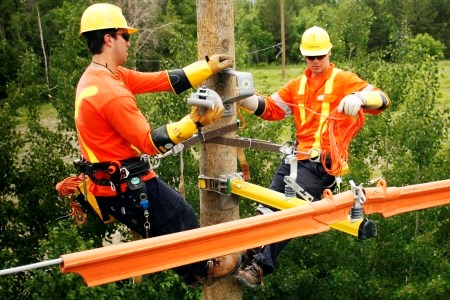The equation is simple: more demand for energy equals more equipment, infrastructure and human resources.
“Everybody wants to be connected,” said Dean Gatien, vice-president of Powertel, a high-voltage electrical contracting specialist based in Whitefish.
As technology evolves, so has the way in which people live and work.
“We never used to have 2,500-square-foot houses with four computers, five televisions, three receivers and HD (high definition) in the house,” Gatien said. “We never used to have servers with multiple programs and 30 computers at the office requiring massive amounts of information to be transferred.”
Other energy demands like upgrading and repairing aging infrastructure, wind farms, air conditioning, and new hospitals place stress on the electrical grid. First Nation communities are also converting from diesel generators to electricity, and new mining projects are coming online in the next few years.
Technology has increased the demands on Ontario’s electrical supply system, which trickles down to the equipment, infrastructure and people responsible for making sure the connections happen.
It is the human resources part of the equation that has become a challenge to fulfill. Cambrian College has long waiting lists of students applying for the electrical and powerline technician trades. As many as 200 to 300 applicants interested in becoming an electrician vie for 125 available spots in September and again in January for 24 openings.
The powerline technician program, only five years old, has more than 300 applicants for 24 available spots in September and January.
Industry is yearning for these trades not only in the North, but across the country. Demographics indicate the retiring workforce from the aging boomer population is having a huge impact on the shortage of skilled trades. As well, a hiring freeze in the ‘90s has had a ripple effect 20 years later.
Cambrian’s electrical program prepare students in three areas: industrial electrician; electrician (domestic and rural), and construction and maintenance electrician, the latter being the most transferable trade. The number of apprenticeship training hours varies between 7,000 and 9,000.
The powerline technician program is two years, requiring 8,000 apprenticeship training hours. Those are Red Seal programs, qualifying the tradesperson to work throughout Canada. They are part of the co-op diploma apprenticeship program, which was introduced at the college in 1998 and adopted provincially in 2004.
The program is an industry-driven model that provides students the option to participate in two 16-week paid co-op placements while earning a college diploma. It also gives employers the opportunity to preview skills of prospective employees while providing input into their training.
SkyTech (Skills Technology Institute) and PowerTech are the entities through which the co-op programs are channelled. Industry representatives sit on the boards of their respective trades, providing input toward curriculum development.
“Our apprentices, through SkyTech (and Powertech), are learning above and beyond what you would learn at trade school,” said Louise Turcotte, SkyTech’s associate dean in the School of Skilled Trades. “Some employers look here first.”
The advantage for the employer is that students who have completed the co-op diploma apprenticeship program will have completed all three levels of the in-school portion of the apprenticeship training and will not have to leave work to attend trade school.
“For an employer, they know they don’t have to send the students back for levels 1, 2, and 3,” said Turcotte. “They only have to focus on the balance of skills.”
Brian Rachkowski, an electrician and instrumentation tradesperson at Vale’s Sudbury operations, plays an active role on three of the college's committees. Rachkowski provides input to make sure the curriculum meets what industry wants, as well as the requirements of the trade.
“There is a high demand for experienced qualified tradespeople,” he said, particularly for small companies that often have their apprentices leave for better-paying jobs with larger employers.
Some of the industries seeking tradespeople are Alberta’s oil and gas plays, Saskatchewan’s potash industry and Northern Ontario’s mining sector.
Ontario Power Generation is another “huge consumer of Cambrian graduates because of the strength of the electrical and instrumentation programs,” as well as the strength of the industry partnerships under the SkyTech model, said Rachkowski.
For the PowerTech program, graduates enter the workforce with the first two levels of their training completed. The program was originally brought forward by Clary and Dean Gatien of Sudbury’s Powertel, and Brian MacMillan, vice-president of Greater Sudbury Hydro, who provide valuable input into the apprenticeship program.
Dean is pleased with the quality of the graduating students because they come in committed to the trade and have completed a quarter of their man-hours. Bruce Cowtan, co-ordinator and instructor of the program, said the attrition rate is very low because the students coming in have at least an 80-plus average out of high school.
In fact, because of the feeding frenzy for qualified people, Cowtan loses some students during their co- op placements.
“They like the money, although I encourage them to come back and finish, because in 10 to 15 years down the road, it will open up doors.”
Cowtan sees the program as a great conduit for students seeking a trade that previously was driven by family legacies.
“Now the applicant can see it in a brochure and find out if they would like to do it, whereas before, if your dad or uncle were not linemen, you didn’t know what a lineman was,” Cowtan said. “It is giving options to people who before, didn’t have it.”




